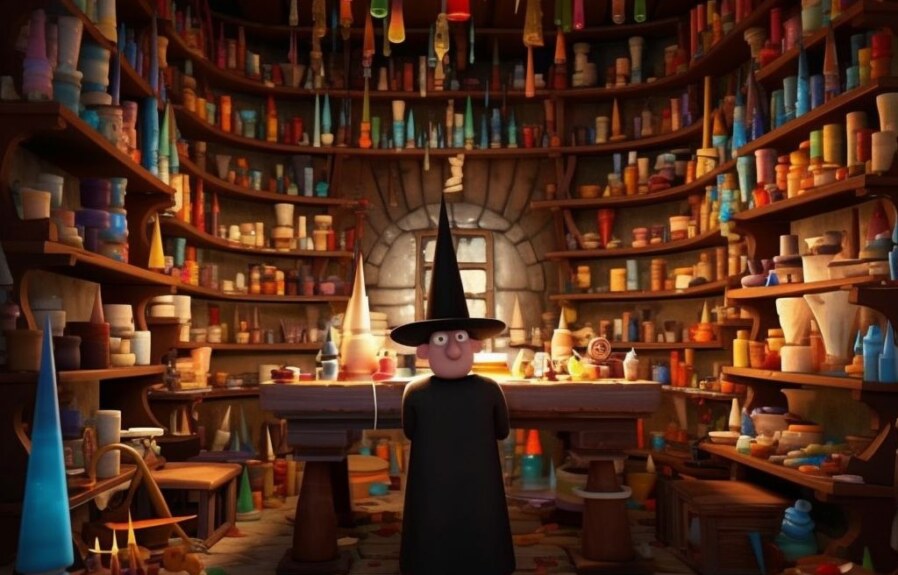Black is often referred to as the absence of color, but it is still an essential hue in many forms of art and design. The color black is all around us, from the deepest shadows to the most classic pieces of clothing. It’s important to know how to make the color black, as it can be a challenge to achieve the perfect tone or shade. Whether you are an artist, designer, or simply interested in learning more about color theory, this article will provide you with the necessary knowledge and tips to create the perfect black. In the following paragraphs, we will discuss the science of color, the different methods of creating black, and examples of how to effectively utilize black in your projects.
1. Understanding the origins and properties of black color
Black is often seen as a mysterious and intense color that can evoke a wide range of emotions. From mourning to sophistication, black has a long history of symbolic meanings in art and culture. But what exactly is black, and how is it created?
At its most basic level, black is the absence of light, meaning that no color is reflected back to our eyes. Instead, all wavelengths of light are absorbed by a surface, creating the appearance of darkness. This means that black does not have a specific wavelength or frequency in the electromagnetic spectrum, unlike other colors like red, green, and blue.
In terms of pigment, black can be created using a range of materials such as charcoal, carbon, and iron oxide. These substances are known as “natural blacks” and have been used for centuries by artists to create the darkest possible shades. However, in modern times, synthetic pigments such as carbon black and ivory black are more commonly used due to their consistency and durability.
When it comes to color mixing, black is not considered a primary color because it cannot be created by mixing any other colors together. Instead, it is often added to other shades to create a darker hue or to mute brighter colors. This is where the use of black in texture, opacity, and layering techniques becomes important, as it can help artists achieve a range of black shades with varying depth and richness.
2. The role of pigment and light absorption in creating black hues
How To Make The Color Black:
Black is a unique color that can be achieved through both additive and subtractive methods. Pigment is the most common way of creating black, which involves mixing various colors to achieve a darkened hue. The role of pigment is to absorb light, which is why darker hues tend to look black. In contrast, white reflects all colors of light, making it the opposite of black.
To create black pigment, it is necessary to combine all three primary colors: red, blue, and yellow. By adding equal parts of each color, a dark, neutral shade of black can be achieved. However, the process of mixing different pigments to create black can be tricky, as pigments can have varying degrees of transparency and opaqueness. This can lead to a variation of hues that are not quite black, but rather a darkened version of the individual colors.
Another method of creating black is through light absorption. Light is composed of varying wavelengths of different colors, and black absorbs all of these wavelengths, resulting in a lack of color perception. This is why black is often used as a background color, as it creates a sense of depth and allows other colors to pop against it.
Overall, the role of pigment and light absorption are essential in creating black hues. By understanding the basic principles of color theory, artists and designers can achieve different shades of black and use them effectively in their projects.
3. Mixing black from primary colors: tips and color theory insights
How to Make the Color Black: Mixing from Primary Colors
Mixing black from primary colors is a skill that every artist and designer must master. Understanding the color wheel and color theory is essential in achieving an accurate and rich black hue. Here are some tips and insights:
The Role of Complementary Colors
In order to mix black from primary colors, it is important to understand the role of complementary colors. Complementary colors are hues that are opposite each other on the color wheel, such as red and green, blue and orange, and yellow and purple. When these colors are mixed, they create a neutral gray. Mixing these gray hues in a ratio of 3:1, with the darker color having 75% and the lighter having 25% of the mix, will result in a deep black color.
Using Cyan, Magenta, and Yellow (CMY) Pigments
In printing, the CMY model is typically used, where cyan, magenta, and yellow pigments are mixed to create a range of colors, including black. However, this method often results in a muddy or washed-out black hue. To achieve a richer and more accurate black, a fourth pigment, black, is added. This color model is known as CMYK.
The proportions of the CMYK pigments needed to create black vary depending on the printing process and the desired effect. However, a common ratio is 60% cyan, 40% magenta, 20% yellow, and 100% black. This formula is known as “rich black” and is commonly used in professional printing.
4. Achieving different black shades through texture, opacity, and layering techniques
How To Make The Color Black
When it comes to black, it’s not just a matter of mixing some paint on your palette. The texture, opacity, and layering techniques you use will have a significant impact on the shade and depth of the black you create.
One of the simplest ways to achieve a different black shade is to vary the texture of your paint. Using a matte black with a rough, gritty texture will give you a different result than using a glossy, smooth black. Choose the texture that best fits the overall look and feel of your project.
Opacity is another factor to consider. A transparent black will appear more muted and grayish than an opaque black. Layering a transparent black over a light-colored background will give you a different look than layering an opaque black over a dark background. Be mindful of the opacity of your black paint when layering it onto your project.
Finally, layering techniques can also impact the shade of black you create. Adding multiple layers of black (or even mixing in different shades of black) can give you a deeper and richer hue. It’s also worth experimenting with layering black over other colors to see how they interact and impact the overall composition.
Next, we’ll look at some unconventional black pigments and color combinations that can add a unique twist to your artwork.
5. Experimenting with unconventional black pigments and color combinations
While black is often associated with darkness, it is also a color that carries a sense of depth and sophistication. Artists and designers can imbue black with unique characteristics by experimenting with unconventional pigments and color combinations.
One such pigment is Ivory Black, made from charred ivory or bone. This pigment has a cool, blue-black undertone and was used extensively by artists in the 19th century. Another alternative is Lamp Black, which is created by burning oil lamps and produces a warm, brown-black shade.
When it comes to color combinations, mixing black with hues such as purple, navy blue, and dark green can create a dramatic and moody effect. Alternatively, pairing black with bright, contrasting colors like orange or fuchsia can create a vibrant and energetic mood.
- TIP: When experimenting with unconventional pigments, it is important to note that some may have toxic or hazardous properties. Always research the materials before use and follow proper safety guidelines.
- TIP: Color harmony and balance are essential in creating successful designs. Use the color wheel to help guide your color combinations and avoid clashing hues.
6. Tips and tricks for using black in art and design projects
Black is a versatile and powerful color that can communicate elegance, sophistication, drama, and even structural strength when used in art and design projects. Here are some tips and tricks to make the most of black in your compositions:
Contrast and Harmony
Black is a great color to create contrast and depth in your artworks or designs by emphasizing the light and shadows in your subject matter. But black can also work well in harmony with other colors, as it enhances their brightness and creates a sense of refinement and balance.
Tip 1: Use black sparingly to make your colors pop. For example, a simple black outline or background can make your colorful illustrations or logos stand out.
Tip 2: Experiment with different color combinations to achieve a wide range of moods and effects. Black pairs well with white, gold, silver, red, and pastels, among others.
Textures and Surfaces
Black can also be used to add tactile qualities and surface variations to your artworks or designs. From matte to glossy, from rough to smooth, black can create a sense of depth and dimensionality that engages the viewer’s senses.
Tip 3: Consider the texture and finish of your materials when working with black. For example, a matte finish can convey a sense of understated elegance, while a glossy finish can create a bold and reflective effect.
Tip 4: Experiment with different layering techniques and opacity settings to create a sense of depth and mystery in your designs. For example, overlapping black shapes or patterns can suggest hidden or overlapping layers of meaning.
In summary, black is a versatile and expressive color that can add drama, elegance, and sophistication to your art and design projects. By mastering the use of contrast, harmony, texture, and layering techniques, you can make the most of black’s rich qualities and create compelling compositions that engage and inspire the viewer.
7. Care and maintenance of black surfaces to preserve their richness and durability
Maintaining the rich appearance and durability of black surfaces is essential when it comes to preserving the integrity of any work of art or design. Without proper care and maintenance, black surfaces can become dull, faded, or discoloured, leading to a poor overall aesthetic impression.
Tips for preserving black surfaces
Clean regularly: Use a soft and clean cloth to wipe down the surface of the artwork or design regularly. This will help prevent the buildup of dust, dirt, and other debris that can cause the surface to become scratched or otherwise damaged.
Avoid direct sunlight: Sunlight can fade black surfaces over time, so it is best to avoid placing them in direct sunlight. If you must place the artwork or design in an area that receives direct sunlight, consider using UV-protective glass to help block out some of the harmful UV rays.
Avoid harsh chemicals: When cleaning black surfaces, avoid using harsh chemicals that can damage the surface of the artwork or design. Instead, use a mild soap and water solution, or a specialized cleaning product designed for use on delicate surfaces.
Conclusion
By following these simple tips and techniques, you can help ensure that your black surfaces remain vibrant and beautiful for years to come. With careful upkeep and proper care, your black artwork or design will continue to impress and inspire for generations to come.
People Also Ask
What colors make black?
To make the color black, you need to mix together all three primary colors: blue, red, and yellow. You can also mix complementary colors, such as blue and orange, red and green, or purple and yellow, to create black.
How much of each color makes black?
When mixing colors to make black, use equal parts of blue, red, and yellow. This will create a neutral black color. If you want a cooler or warmer black tone, adjust the amounts of each color accordingly.
What happens if you mix all the colors together?
If you mix all the colors together, you will get a muddy brown color, but not black, because white is still present. White is the absence of color, so you will need to eliminate it to achieve black.
Can you make black with just one color?
No, you cannot make black with just one color, as black is not a hue, but rather the absence of color.
What is the darkest color?
The darkest color is black, as it is the absence of light and color.
Conclusion
To make the color black, you need to mix all three primary colors, blue, red, and yellow, or complementary colors in equal parts. Mixing all colors together will not produce black, as white is still present. While black is the absence of color, it is the darkest hue and an essential color in art, design, and fashion.



